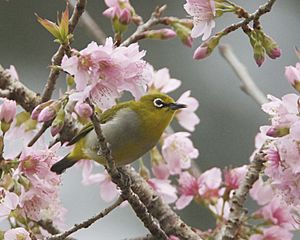Wild Himalayan cherry facts for kids
Quick facts for kids Wild Himalayan cherry |
|
|---|---|
 |
|
| An Indian white-eye bird sitting on a Wild Himalayan Cherry tree. | |
| Scientific classification | |
| Synonyms | |
|
The Wild Himalayan Cherry, also known as Prunus cerasoides or the sour cherry, is a beautiful tree found in parts of Asia. It's a type of cherry tree that loses its leaves every year. This tree belongs to the Rosaceae family, which includes roses and apples, and it's part of the Prunus group.
You can find the Wild Himalayan Cherry growing in the Himalayas, from India all the way to Southwest China, Burma, and Thailand. It likes to grow in cool, temperate forests at high places, usually between 1,200 and 2,400 meters (about 3,900 to 7,900 feet) above sea level.
Contents
What Does the Wild Himalayan Cherry Look Like?
The Wild Himalayan Cherry tree can grow quite tall, reaching up to 30 meters (about 98 feet) high. It has shiny bark that looks like it has rings around it. When the tree is not flowering, you can still recognize it by its glossy, ringed bark and long, toothed leaf-like parts called stipules.
This tree blooms during autumn and winter. Its flowers are pinkish-white and have both male and female parts (meaning they are hermaphroditic). The fruit starts as a yellow, oval shape and turns red when it gets ripe.
How People Use This Tree
Growing Wild Himalayan Cherry Trees
The Wild Himalayan Cherry is often grown as a beautiful ornamental tree in gardens and parks. It grows best in soil that drains well but also holds moisture, like loamy soil. It prefers a sunny spot that is also protected from strong winds.
Like most Prunus trees, the Wild Himalayan Cherry has roots that don't go very deep. If its roots get hurt, it might grow many new shoots from the base, called suckers. The tree can also get a condition called chlorosis if there's too much lime in the soil, which makes its leaves turn yellow. It can also be affected by a plant disease called honey fungus.
To grow this tree from a seed, the seed needs to be kept cold for two to three months. It's best to plant the seed in a cold frame as early in winter as possible. The seeds grow slowly and can sometimes take about 18 months to sprout, depending on the conditions.
Edible Parts of the Tree
- Fruit — The fruit is about 15 millimeters (0.6 inches) wide. You can eat it raw or cook it.
- Gum — A sticky substance, called gum, can be taken from the tree's trunk. People chew this gum, and it can also be used as a replacement for another type of gum called gum tragacanth.
- Seed — The seeds can also be eaten raw or cooked.
Other Cool Uses
The fruits and leaves of the Wild Himalayan Cherry can be used to make a dark green dye. The seeds are sometimes used to create pretty necklaces.
The wood from this tree is strong, hard, and smells nice. People also use its branches as walking sticks.
See also
 In Spanish: Prunus cerasoides para niños
In Spanish: Prunus cerasoides para niños

